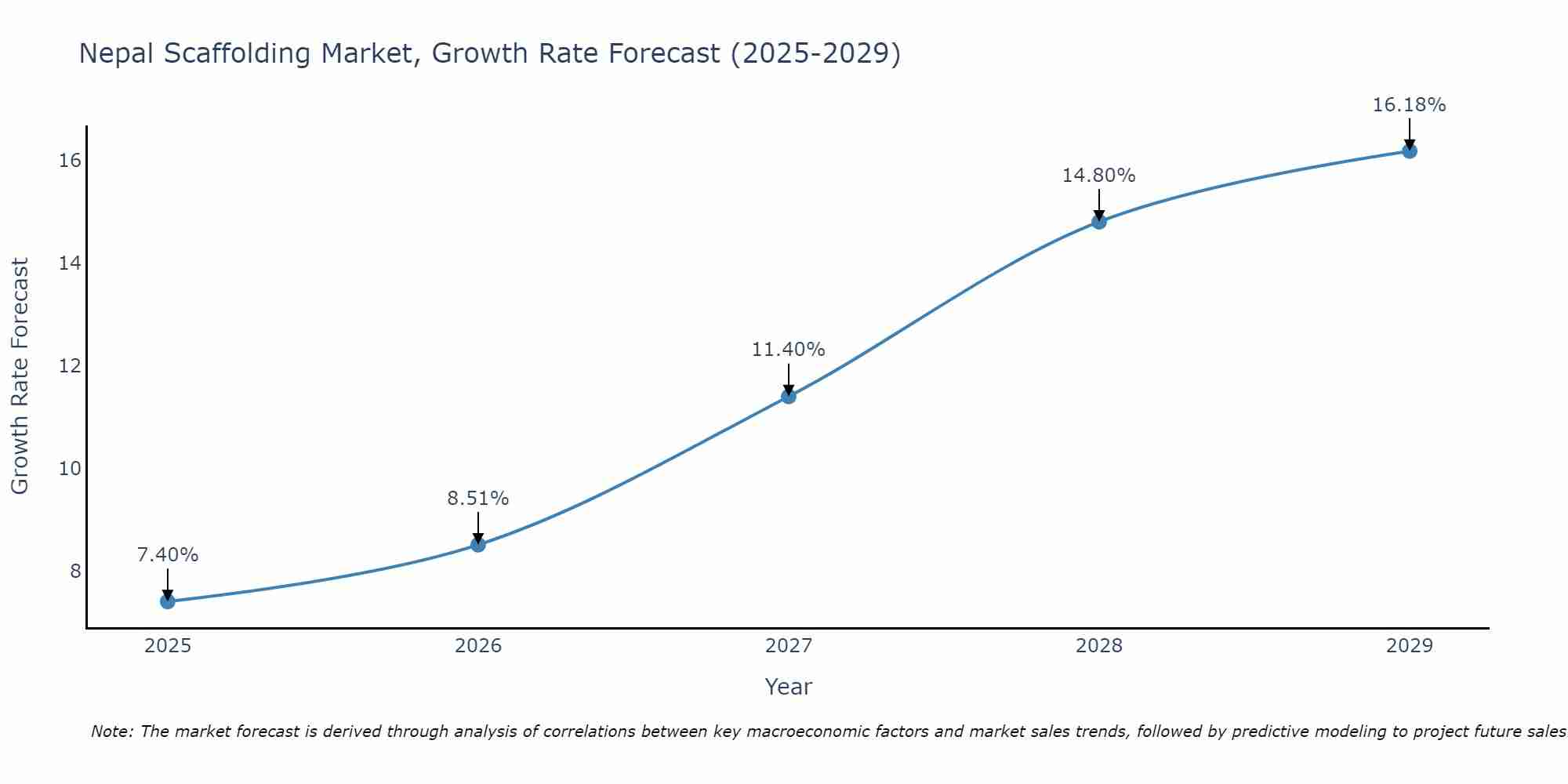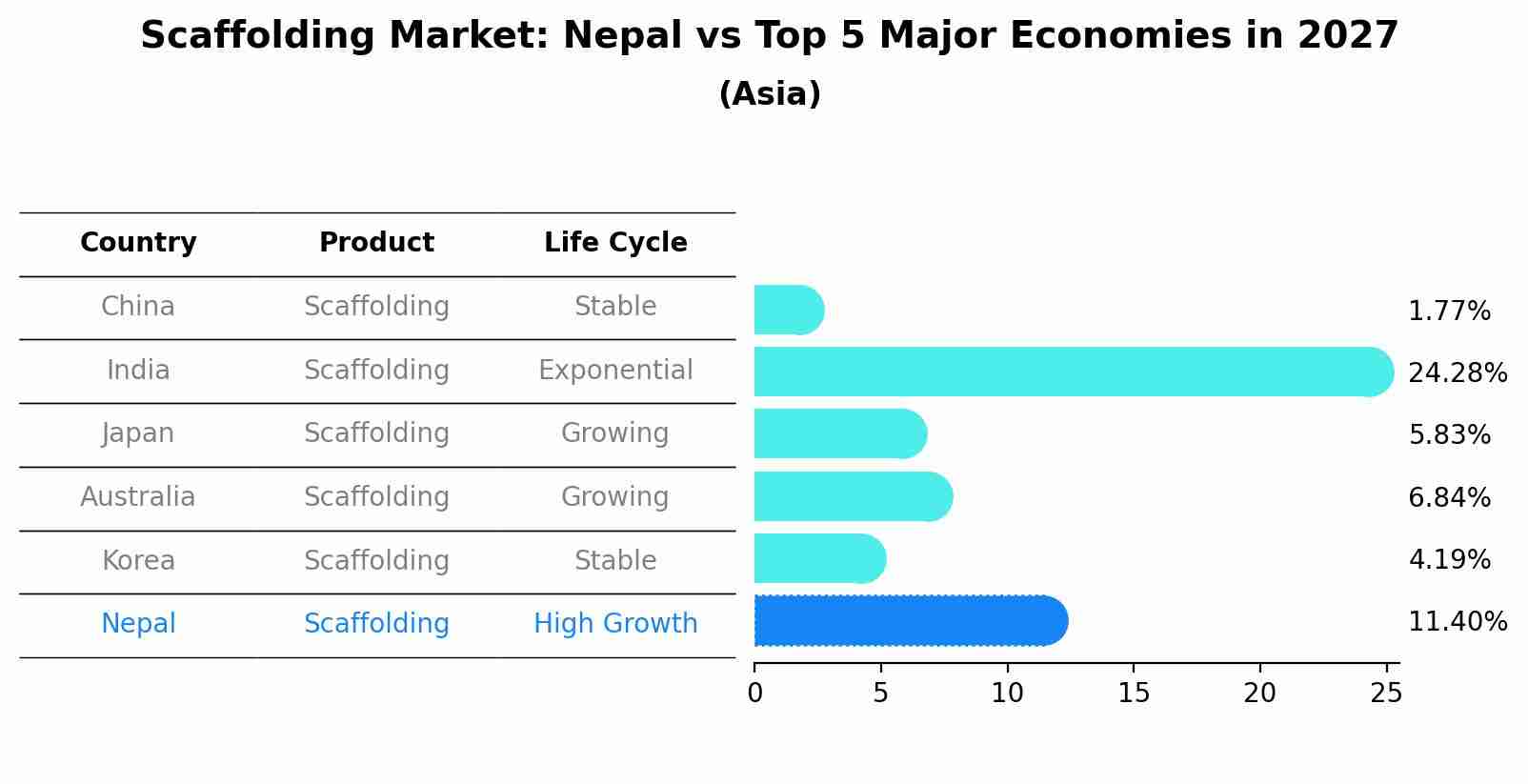Nepal Scaffolding Market (2025-2031) Outlook | Forecast, Analysis, Size, Share, Trends, Value, Companies, Revenue, Growth & Industry
| Product Code: ETC377796 | Publication Date: Aug 2022 | Updated Date: Jul 2025 | Product Type: Market Research Report | |
| Publisher: 6Wresearch | Author: Vasudha | No. of Pages: 75 | No. of Figures: 35 | No. of Tables: 20 |
Nepal Scaffolding Market Size Growth Rate
The Nepal Scaffolding Market is likely to experience consistent growth rate gains over the period 2025 to 2029. The growth rate starts at 7.40% in 2025 and reaches 16.18% by 2029.

Scaffolding Market: Nepal vs Top 5 Major Economies in 2027 (Asia)
By 2027, Nepal's Scaffolding market is forecasted to achieve a high growth rate of 11.40%, with China leading the Asia region, followed by India, Japan, Australia and South Korea.

Nepal Scaffolding Market Synopsis
The Nepal scaffolding market is experiencing steady growth due to increased construction activities in the country. The market is primarily driven by the booming real estate sector, infrastructure development projects, and the growth of the industrial sector. The demand for scaffolding products such as steel, aluminum, and wooden scaffolding systems is on the rise as these are essential for providing temporary support and access during construction works. With the government focusing on improving infrastructure and promoting investments in construction projects, the scaffolding market in Nepal is expected to continue its growth trajectory. Key players in the market are focusing on product innovation, safety features, and cost-effective solutions to cater to the diverse needs of construction companies and contractors in the region.
Nepal Scaffolding Market Trends
The Nepal scaffolding market is experiencing several key trends. One major trend is the increasing adoption of lightweight and durable aluminum scaffolding systems over traditional steel scaffolding due to their portability and ease of assembly. Another trend is the growing demand for eco-friendly scaffolding materials, leading to the use of sustainable bamboo scaffolding in construction projects. Additionally, there is a rising focus on safety standards and regulations in the industry, driving the implementation of advanced safety features in scaffolding systems. Furthermore, the market is witnessing a shift towards modular scaffolding solutions that offer flexibility and efficiency in construction projects. Overall, these trends indicate a gradual evolution and modernization of the scaffolding industry in Nepal.
Nepal Scaffolding Market Challenges
The Nepal scaffolding market faces several challenges, including the lack of standardized regulations and safety protocols, leading to potential safety hazards for workers. Additionally, there is a shortage of skilled laborers with proper training in scaffolding erection and dismantling, which can compromise the efficiency and quality of construction projects. The presence of low-quality and counterfeit scaffolding materials in the market also poses a challenge, as they can lead to structural failures and accidents on construction sites. Moreover, the fluctuating prices of raw materials and economic instability in the region can impact the overall growth and sustainability of the scaffolding market in Nepal. Addressing these challenges through improved regulations, training programs, quality control measures, and market stabilization efforts will be crucial for the development of the scaffolding industry in Nepal.
Nepal Scaffolding Market Investment Opportunities
The Nepal scaffolding market presents various investment opportunities due to the country`s booming construction industry. As Nepal continues to invest in infrastructure development, the demand for scaffolding products and services is on the rise. Investing in manufacturing and supplying high-quality scaffolding materials, such as steel tubes, couplers, and boards, can be lucrative. Additionally, there is a growing need for scaffolding rental services to cater to construction projects of varying scales. Partnering with local construction companies to provide scaffolding solutions or establishing a scaffolding rental business could be a promising venture. Moreover, with the government`s focus on promoting sustainable development, investing in eco-friendly scaffolding solutions could also be a strategic move to capitalize on the market demand while aligning with environmental objectives.
Jordan Agar Market Government Policies
Government policies related to the Nepal Scaffolding Market include regulations on safety standards, licensing requirements, and environmental considerations. The government has implemented guidelines to ensure the structural integrity of scaffolding equipment, training for workers on safe practices, and periodic inspections to prevent accidents. Additionally, licensing requirements are in place to ensure that only qualified and certified companies can operate in the market. Environmental considerations are also taken into account, with regulations on the use of sustainable materials and disposal of scaffolding equipment. Overall, the government policies aim to promote safe and responsible practices in the Nepal scaffolding market while also supporting sustainability efforts.
Nepal Scaffolding Market Future Outlook
The Nepal scaffolding market is expected to witness steady growth in the coming years, driven by increasing construction activities, infrastructure development projects, and government initiatives. The market is likely to benefit from the growing demand for high-quality and safe scaffolding solutions to support the construction of commercial and residential buildings, bridges, and other structures. Additionally, technological advancements in scaffolding materials and designs are anticipated to enhance efficiency and safety on construction sites, further boosting market growth. With a focus on improving safety standards and regulations in the construction industry, the Nepal scaffolding market is poised for expansion as the country continues to invest in its infrastructure and urban development projects.
Key Highlights of the Report:
- Nepal Scaffolding Market Outlook
- Market Size of Nepal Scaffolding Market, 2024
- Forecast of Nepal Scaffolding Market, 2031
- Historical Data and Forecast of Nepal Scaffolding Revenues & Volume for the Period 2021 - 2031
- Nepal Scaffolding Market Trend Evolution
- Nepal Scaffolding Market Drivers and Challenges
- Nepal Scaffolding Price Trends
- Nepal Scaffolding Porter's Five Forces
- Nepal Scaffolding Industry Life Cycle
- Historical Data and Forecast of Nepal Scaffolding Market Revenues & Volume By Type for the Period 2021 - 2031
- Historical Data and Forecast of Nepal Scaffolding Market Revenues & Volume By Supported Scaffolding for the Period 2021 - 2031
- Historical Data and Forecast of Nepal Scaffolding Market Revenues & Volume By Suspended Scaffolding for the Period 2021 - 2031
- Historical Data and Forecast of Nepal Scaffolding Market Revenues & Volume By Rolling Scaffolding for the Period 2021 - 2031
- Historical Data and Forecast of Nepal Scaffolding Market Revenues & Volume By Material for the Period 2021 - 2031
- Historical Data and Forecast of Nepal Scaffolding Market Revenues & Volume By Aluminum for the Period 2021 - 2031
- Historical Data and Forecast of Nepal Scaffolding Market Revenues & Volume By Wood for the Period 2021 - 2031
- Historical Data and Forecast of Nepal Scaffolding Market Revenues & Volume By Steel for the Period 2021 - 2031
- Historical Data and Forecast of Nepal Scaffolding Market Revenues & Volume By End User for the Period 2021 - 2031
- Historical Data and Forecast of Nepal Scaffolding Market Revenues & Volume By Residential for the Period 2021 - 2031
- Historical Data and Forecast of Nepal Scaffolding Market Revenues & Volume By Commercial for the Period 2021 - 2031
- Historical Data and Forecast of Nepal Scaffolding Market Revenues & Volume By Industrial for the Period 2021 - 2031
- Nepal Scaffolding Import Export Trade Statistics
- Market Opportunity Assessment By Type
- Market Opportunity Assessment By Material
- Market Opportunity Assessment By End User
- Nepal Scaffolding Top Companies Market Share
- Nepal Scaffolding Competitive Benchmarking By Technical and Operational Parameters
- Nepal Scaffolding Company Profiles
- Nepal Scaffolding Key Strategic Recommendations
Frequently Asked Questions About the Market Study (FAQs):
- Single User License$ 1,995
- Department License$ 2,400
- Site License$ 3,120
- Global License$ 3,795
Search
Thought Leadership and Analyst Meet
Our Clients
Related Reports
- Canada Oil and Gas Market (2026-2032) | Share, Segmentation, Value, Industry, Trends, Forecast, Analysis, Size & Revenue, Growth, Competitive Landscape, Outlook, Companies
- Germany Breakfast Food Market (2026-2032) | Industry, Share, Growth, Size, Companies, Value, Analysis, Revenue, Trends, Forecast & Outlook
- Australia Briquette Market (2025-2031) | Growth, Size, Revenue, Forecast, Analysis, Trends, Value, Share, Industry & Companies
- Vietnam System Integrator Market (2025-2031) | Size, Companies, Analysis, Industry, Value, Forecast, Growth, Trends, Revenue & Share
- ASEAN and Thailand Brain Health Supplements Market (2025-2031) | Strategy, Consumer Insights, Analysis, Investment Trends, Opportunities, Growth, Size, Share, Industry, Revenue, Segments, Value, Segmentation, Supply, Forecast, Restraints, Outlook, Competition, Drivers, Trends, Demand, Pricing Analysis, Competitive, Strategic Insights, Companies, Challenges
- ASEAN Bearings Market (2025-2031) | Strategy, Consumer Insights, Analysis, Investment Trends, Opportunities, Growth, Size, Share, Industry, Revenue, Segments, Value, Segmentation, Supply, Forecast, Restraints, Outlook, Competition, Drivers, Trends, Demand, Pricing Analysis, Competitive, Strategic Insights, Companies, Challenges
- Europe Flooring Market (2025-2031) | Outlook, Share, Industry, Trends, Forecast, Companies, Revenue, Size, Analysis, Growth & Value
- Saudi Arabia Manlift Market (2025-2031) | Outlook, Size, Growth, Trends, Companies, Industry, Revenue, Value, Share, Forecast & Analysis
- Uganda Excavator, Crane, and Wheel Loaders Market (2025-2031) | Strategy, Consumer Insights, Analysis, Investment Trends, Opportunities, Growth, Size, Share, Industry, Revenue, Segments, Value, Segmentation, Supply, Forecast, Restraints, Outlook, Competition, Drivers, Trends, Demand, Pricing Analysis, Competitive, Strategic Insights, Companies, Challenges
- Rwanda Excavator, Crane, and Wheel Loaders Market (2025-2031) | Strategy, Consumer Insights, Analysis, Investment Trends, Opportunities, Growth, Size, Share, Industry, Revenue, Segments, Value, Segmentation, Supply, Forecast, Restraints, Outlook, Competition, Drivers, Trends, Demand, Pricing Analysis, Competitive, Strategic Insights, Companies, Challenges
Industry Events and Analyst Meet
Whitepaper
- Middle East & Africa Commercial Security Market Click here to view more.
- Middle East & Africa Fire Safety Systems & Equipment Market Click here to view more.
- GCC Drone Market Click here to view more.
- Middle East Lighting Fixture Market Click here to view more.
- GCC Physical & Perimeter Security Market Click here to view more.
6WResearch In News
- Doha a strategic location for EV manufacturing hub: IPA Qatar
- Demand for luxury TVs surging in the GCC, says Samsung
- Empowering Growth: The Thriving Journey of Bangladesh’s Cable Industry
- Demand for luxury TVs surging in the GCC, says Samsung
- Video call with a traditional healer? Once unthinkable, it’s now common in South Africa
- Intelligent Buildings To Smooth GCC’s Path To Net Zero


















